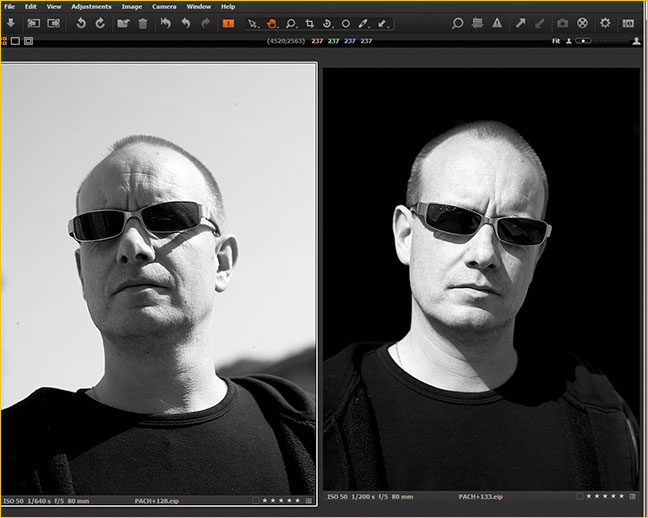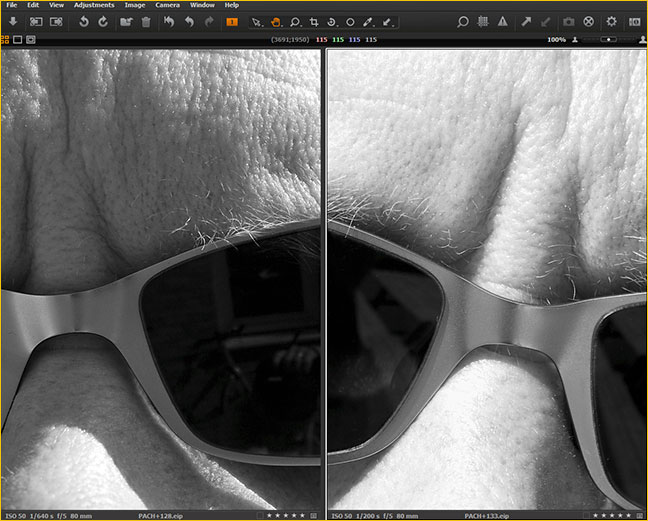
Hardy Lake #2 – Muskoka, Ontario. September, 2009
Phase One 645 with 28mm lens and Achromatic back @ ISO 200
What Is It and Where Did it Come From?
Jim Taskettis the man behindBear Imaging, a specialty products VAR and photographic equipment reseller located in Silicon Valley. He is aPhase Onedealer, and among his customer are a great many universities, museums, scientific research labs, and government agencies, not to mention more than a few commercial, industrial and fine art photographers.
Many, if not most of these customers have specialized photographic requirements. This often includes extremely high resolution, infrared, ultraviolet, monochrome, as well as narrow bandpass imaging.
Historically these needs have been met with a variety of specialized films. But many of these are becoming increasingly scarce and are falling out of production. What has therefore been needed is a digital solution, but till now this has been more easily said than done.
The problem is that while sensors themselves are monochrome devices, 99.99% of all sensors made are equipped with a Bayer pattern filter which effectively turns them into colour devices. This is done by placing red, blue and green filters over each photo site and then using some pretty sophisticated math to "guess" what the real colours in the scene were through a process of interpolation. You can read more about ithere.
Kinky as it sounds, it works, and works remarkably well. With the exception of a few Foveon sensor equipped cameras, this is the way that every digital camera records colour images.
The downside (or at least one of them) is that this process of colour interpolation reduces resolution. Depending on who you talk to this can be by a factor of about one third.

Webs – Torrance Barrens, Ontario. September, 2009
Phase One 645 with 75-150mm lens and Achromatic back @ ISO 100
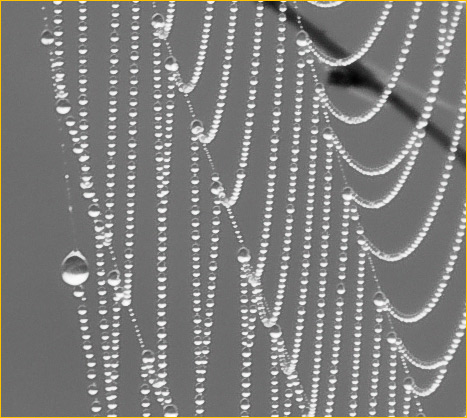
100% Enlargement
Also, silicon sensors record not just visible light, but also somewhat into the ultraviolet and well into the infrared. This strong IR sensitivity needs to be blocked so that it does not influence proper recording of colour images (remember the Leica M8?). Thus, all digital cameras have a built-in infrared blocking filter. This is fine for normal photography, but in many scientific and technical pursuits one wants to be able to record the IR frequencies. Applications include forensics, surveillance, art conservation, crop mapping, and bio-tech research.
Finally, almost all digital camera sensors have antialiasing filters. These are there because it is possible for the sensor grid pattern to alias (beat) when photographing ultra-fine man-made patterns found in fabrics, for example. This was more of a problem when sensors were under 10 Megapixels than it is today, but almost all DSLRs have AA filters, even though its occurrence is rare and can be fixed in software. Oh yes – AA filters also reduce resolution. In other words, a digital camera with an AA filter, and which uses a Bayer Matrix (which means almost every DSLR currently on the market), in theory loses as much as 50% of its potential resolution. (We’ll see soon if this is indeed the case).
It needs to be said that almost all medium format backs dispense with AA filters, while the only current 35mm format camera that doesn’t have one is the new M9. This is one of the reasons for these cameras’ image clarity, which has as much to do with their lack of an AA filter as it does their resolution.
With all of this as background, a couple of years ago Jim Taskett approached Phase One with a request for a back that shot monochrome (no Bayer Matrix) and which didn’t have an IR blocking filter or an AA filter. In other words, just a raw monochrome sensor.
One would think that this would be easy enough to accomplish, but it turned out not to be the case. In fact it took some two years and several patent applications on the part of Phase One till the Achromatic back became a reality.
The sensor is the standard Kodak sensor as used in the P45+ back. But, it’s my understanding that the ones used in the Achromatic back are hand picked from the best of the best, therefore requiring less individual chip calibration.
Phase One medium format backs are individually "mapped" for their defects – which all sensors have. A monochrome sensor is much less tolerant of these "bad" pixels and rows because the Bayer matrix has a way of "masking" them, thus allowing a higher tolerance for these defective photo sites.
___________________________________________________________________________________
What Problem(s) Does The Achromatic Solve – and Create?
For institutions and researchers who require the highest levels of resolution, who don’t need full colour, who need to be able to record into the infra-red, as well as those who have the need to record images at very specific optical frequencies, a camera such as the Achromatic fills the bill.
For landscape and nature photographers it is the answer to a question that many knowledgeable photographers who work in B&W have been asking –why can’t we have the optical purity of a monochrome camera and regain the resolution lost to the Bayer pattern filtering?
If you used to (or still do) shoot B&W film then you know that you can use certain filters in front of the lens to create desired pictorial effects. A red or orange filter to darken blue skies and make clouds stand out, a green filter to lighten foliage, and so forth.
But, for those that shoot digital in colour and then convert to monochrome during processing, this isn’t necessary, because we can use controls such as Channel Mixer in Photoshop, or the Grayscale Mixer in Lightroom to vary the luminance levels of various colour channels and achieve much the same effect.
With the Achromatic back we’re back to the same field practice as when we shot B&W film.
___________________________________________________________________________________
Using Filters
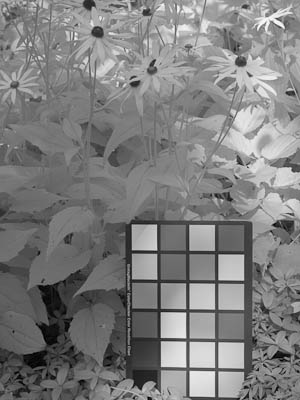
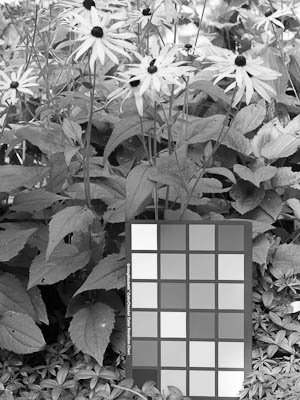

No Filter
ISO 100
f/16
1/80 sec
ISO 100
f/16
1/6 sec
B+W 093 IR Pass Filter
ISO 100
f/16
1/10 sec
Because the Phase One Achromatic has no filtration whatsoever (there is simply a thin glass cover plate over the sensor for physical protection), it records light covering the full visible spectrum, and also from down into the UV to well into the infra-red.
For the technical and scientific photographer this provides the opportunity to utilize very narrow band pass filters, enabling the recording of specific frequencies without hindrance.
For the nature and landscape photographer this ultra-wide bandwidth can be problematic. Firstly, it makes exposure determination very difficult because the exposure will vary dramatically from what is metered, depending on the amount of IR reflecting matter in the shot. A leaf and a rock might meter as having the same exposure within the visible spectrum, but because of its high IR reflectivity the plant will expose quite differently. The rock may expose differently as well, depending on how much heat its absorbed from the sun, but which will be completely immaterial within the visible spectrum.
If you wish to reduce bandwidth to just the visible spectrum you can either attach a Phase One TG1 filter to the front of the lens used, or your can order the Achromatic back with one built in.
A TG1 filter is a special lens mount filter designed to perform the task of the IR block filter used on all other cameras in front of the sensor itself.
If you want to explore the world of Infra-red photography you can use an IR pass filter, such as the B+W 093, which only allows infra-red light through. This becomes problematic though for two reasons. The first is that you can not view though the lens while the filter is in place as it is completely opaque to visible light. The second reason is that IR light focuses on a different plane than does visible light. This means that your focus will be off, and even stopping down to f/16 isn’t enough to compensate.
Lenses used to have IR focusing marks, but for the most part these disappeared years ago. In a technical environment one can take steps to compensate for this focus shift, but for day-to-day outdoor shooting there is no simple solution.
Because of the Achromatic’s high IR sensitivity when used without a TG1 filter there can sometimes be focus issues as well, even when not using an IR pass filter. The reason for this is that if the subject (a leaf, for example) is at the same plane of focus as a branch, the leaf may look somewhat out of focus due to its high IR content while the branch is pin sharp. This effect is visible in some of the images used as illustrations in the article. It’s not a wholly unpleasant look, and indeed has a unique charm, but it may not be what you’re after.
For this reason my recommendation, if you’re considering purchasing an Achromatic, is to get a back without any UV/IR filtration and then purchase a TG1 filter for use on ones lenses when desired. If you go for an Achromatic back with the filter built in, you gain convenience, but lose the ability to explore the wonderful world of mixed visible and IR monochrome photography. The choice is yours, but this is what I’d do.
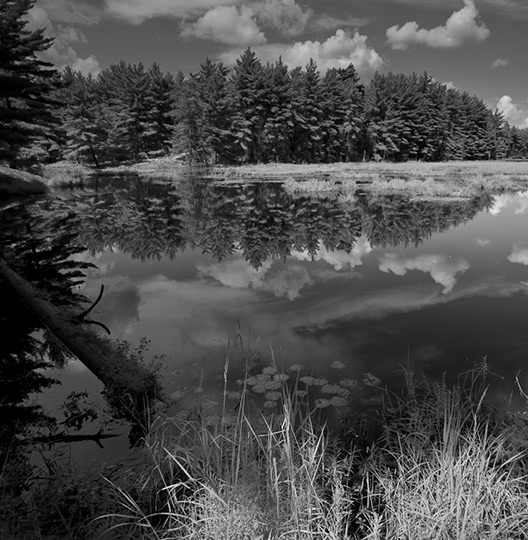
Hardy Lake #2 – Muskoka, Ontario. September, 2009
Phase One 645 with 28mm lens and Achromatic back @ ISO 200
___________________________________________________________________________________
Spectral Response
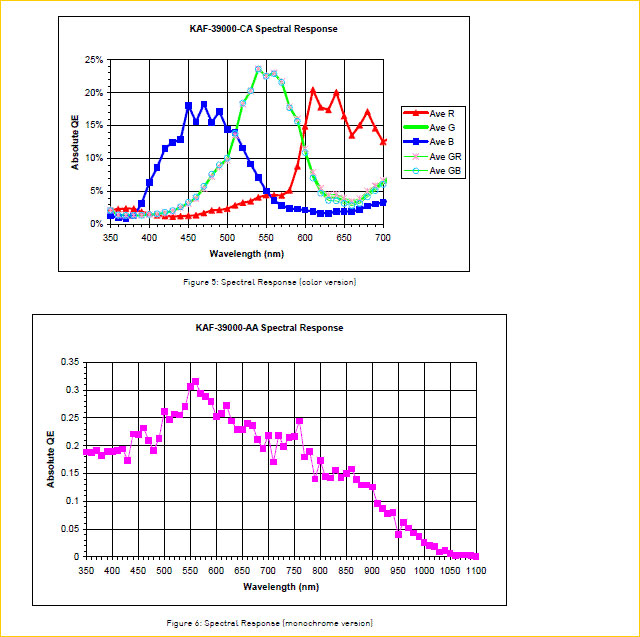
Image courtesy of EASTMAN KODAK COMPANY
In order for the more scientifically interested within the photographic community to understand the significance of what can be recorded with an Achromatic+, above is the spectral response curve for the monochrome image sensor in Achromatic+ and the color image sensor in P45+ backs (not showing the effect of the IR cut-off filter). The visible spectrum is approximately from 400nm to 750nm. When you look at the response curve for the Achromatic+ you will see that it has a tremendous capability to see the ‘invisible’ UV and IR parts.
___________________________________________________________________________________
Comparisons
I had planned to do some pixel peeping comparisons with a P45+ and a P65+. In fact I did them, setting up the shot on a heavy tripod firmly planted on concrete, 120mm Macro lens at optimum aperture, manual focus tripple checked with a 3X magifier, mirror lockup, eletronic cable release – the whole nine yards.
I processed the files, and examined them with and without optimium sharpening.
So why aren’t the results here? Simply because I can’t see any convincing difference in resolution or sharpness between them. Yes, the P65+ file is bigger and therefore will take more magnification. But between the Achromatic and the P45+ on which it’s based I just don’t consistently see anything to convince me that the non-Bayer Achromatic consistently offers sharper results.
This of course flies in the face of common wisdom, that the Bayer Array robs digital files or their inherent monochrome resolution. While that may be the case in the lab, in the real world, using the best shooting technique I know, I can’t see it.
In the end then if one is considering an Achromatic back it should be not for any resolution advantage but for its wide gamut, including the UV and IR, if desired. For the technical user the benfits wll be clear. For the fine art user I think it’s a much tougher call since one has the ability to change the luminance values of colours in post, rather than being limited to doing so at the time of exposure.
For the rest of us – those who won’t be buying an Achromat – it’s nice to know that a modern camera without an AA filter gives up hardly any resolution because of the Bayer Array. But that mixed visible light / IR looks sure is appealing.
___________________________________________________________________________________
Where to Get One and What Does it Cost?
The Achromatic back was designed built by Phase One, but it is a specialty product targeted primarily at the scientific community at the behest ofBear Images. Therefore, though from Phase One, Achromatic backs are available exclusively through Bear Imaging in the U.S.
Bear is setting up a small number of resellers around the world including through Phase One’s Canadian DistributorB3K Digital, and Walter Borchenko, who was kind enough to arrange for Jim to loan me an Achromatic back for this test.
This cost of an Achromatic back is US $41,990 from Bear in the U.S., and CDN $45,995 from B3K in Canada. Bear and B3K are offering the product with a 1 year warranty. There is a 1 year extension available at USD $2,000.00, and the IR Blocking Filter supplied with the Achromatic+ will be a BG38IR.
A web page devoted to the Achromatic back is now online.
October, 2009
___________________________________________________________________________________
A Second Opinion – By Mark Dubovoy
Mark Dubovoy is a regular contributor to this site as well as a P65+ user. He happens to live close to Bear Imaging and after reading a draft of my review above decided to test the Achromatic for himself. Here is what he reports…
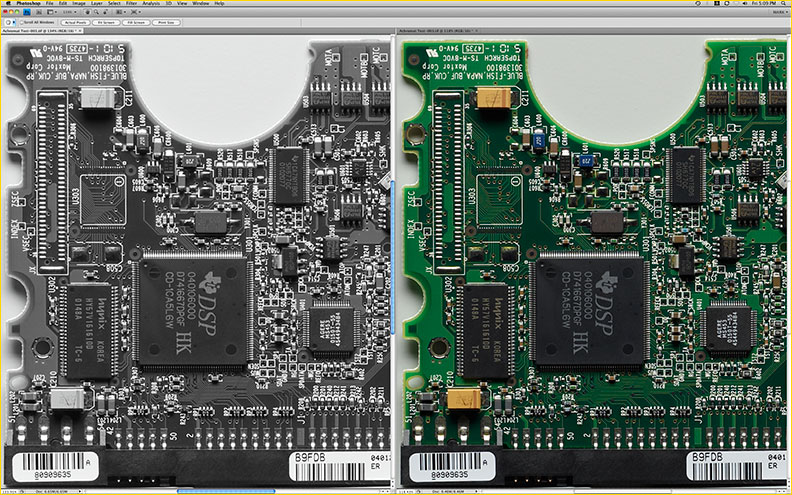
I just finished my favorite resolution test, comparing the Achromatic, a P45+ and a P65+ using a very complex circuit board with lots of small components and small traces.
The attached screen shots are enlarged sections of the original image. In the screen shot seen above you will see the images at 118% and 134% respectively; I did this so the size of the components on the boards would be the same. The second screen shot below shows both backs at 200%. The B&W images were taken with the Achromatic back using the Phase One TG1 filter. The color images were taken using my P65+.

All images were shot with an Alpa SWD focusing on the groundglass with my good old eyes. I used the Rodenstock 100 mm APO HR lens at F/8 which is very close to its optimum aperture. The files were converted to TIFF in the latest version of Capture One with no adjustments and no sharpening. The files were then opened in Photoshop CS4 and enlarged for the attached screen shots.
Conclusion:The Achromatic back definitely has more resolution than a standard P45+ back. Compared to a P65+, however, the Achromatic back looses, but not by much.
You need to look carefully, and of course I have the advantage of the original files, so if you cannot see it in your computers, you will have to trust me that the P65+ has slightly superior resolution to the Achromatic back. I would say that the resolution of the Achromatic back is about 2/3 of the way between a standard P45+ and a P65+.
_________________________
I have personally made comparisons between the standard P45+ and the P65+ on the Phase One 645 camera with Phase / Mamiya lenses. Although the "look" of the P65+ is much more pleasing, with better microdynamics, better color shading/color saturation and better dynamic range, when using the Phase One camera, I can see no difference in resolution between the two backs.
On the other hand, when I use either the Alpa or the Linhof with HR lenses, there is a very noticeable difference in resolution between a P45+ and a P65+.
It all fits together. Hurrah for the laws of Physics!
– Mark Dubovoy
_________________________
A Third Opinion – By Claus Mølgaard
Dr. Claus, as he is known, is Chief Technology Officer and Vice President R&D at Phase One. I was curious as to his thoughts on the Achromatic and so sent a final draft of this review to him for his comments. These are reproduced below.
Our testing of the Achromatic+ and its ability to resolve fine details is very much in line with Mark’s conclusion (above).
I have attached 4 screen dumps from Capture One. Two images show a comparison between P45+ and Achromatic+ and two are samples of portraits done with the Acromatic+ back.

ACHROMATIC+ VS. P45+ at 100%

ACHROMATIC+ VS. P45+ at 300%
These two images show a comparison between P45+ and Acromatic+. Both images are shot using a Hasselblad V, using a Carl Zeiss Makro-Planar 4/120 CFE at f8 using flash. The Acromatic shot used a TG1 filter. Both images are using default sharpening in Capture One.
What to look for:
Look at the text in the watch saying CITIZEN QUARTZ. It is much easier to read the text in the Achromatic+ version.
Look at how precise the Achromatic defines the hands of the watch.
Look at how precise the round shape of the whole watch is defined in the Achromatic+ version.
In the 100% zoom look at the black dots in the red tomatos on the tomato can. Here the definition is far better in the Achromatic version.
My conclusion:
Even though that the P45+ has a fantastic ability to resolve details only 1 pixel wide, it is evident that the Achromatic+ back adds a whole new dimension to how precise these details can be defined.
ACHROMATIC+ PORTRAIT SAMPLES
ACHROMATIC+ PORTRAIT SAMPLES at 100%
These 2 images are shot using the Achromatic+ back on a Phase One 645 AF camera using Phase One 80mm f/2.8 at f5. A TG1 filter has been used.
What to look for:
These are examples of B/W portraits using the Achromatic+ backs in strong direct sunlight. The images deal with a very large dynamic range and produce very nice looking portraits with information in the deepest shadows as well as the intense highlights. Zooming in on the sunglasses again you see how well the edges are defined.
I was personally excited to use the Achromatic+ in the near-infrared part of the spectrum to create unique looking portraits with beautiful skin look. Thanks again for taking the time to try out this new unique BW camera, which I hope will excite BW and IR enthusiasts as well as the scientific community.
– Claus Mølgaard
You May Also Enjoy...
Hasselblad H3D 50 II Multishot Versus Phase One P65+ / 645AF
INTRODUCTIONI would like to begin this article with a few basic philosophical points. One can literally go crazy doing scientifically accurate tests of equipment. These
Tree On A Hill
Tree On The HillNikon D800e With 80-400mm lens Seeing it Is The First PartAfter working a good part of the day on Luminous-Landscape business, Michael Reichmann
